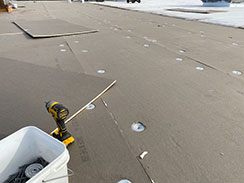 Flat roofs are so popular that you find them almost everywhere, be it malls, warehouses, and especially in commercial, industrial, and institutional buildings. When deciding if a flat roof is best for you, consider various factors such as climate, maintenance, cost, and aesthetics. Despite numerous benefits, flat roofs do have a reputation for leaks and repairs. The good news is that with an excellent roofing company by your side such as Hoppe Roofing in Brookings, SD, you should have absolutely nothing to worry about!
Flat roofs are so popular that you find them almost everywhere, be it malls, warehouses, and especially in commercial, industrial, and institutional buildings. When deciding if a flat roof is best for you, consider various factors such as climate, maintenance, cost, and aesthetics. Despite numerous benefits, flat roofs do have a reputation for leaks and repairs. The good news is that with an excellent roofing company by your side such as Hoppe Roofing in Brookings, SD, you should have absolutely nothing to worry about!
Types of Flat Roofs

There are three types of flat roofs: Built-up roof (BUR), Single-layer membrane roof, and Modified bitumen roof.
Built-Up Roof (BUR) allows for simple repair and an easy dismantling process along with low operating and maintenance costs across its 10- to 15-year lifespan. It also provides excellent protection against harsh weather, UV rays, and water. However, as with every roofing system, this gets damaged over time. One downside may be that it can require you to dismantle the entire roof to locate the cause of damage. Therefore, prevention is always better than cure and a watchful eye will ensure that your roof lives on for years to come.
Single-Ply Membrane Roof is also a great option because it is known for being light weight and flexible, reducing stress on your building’s structure. The installation is also simpler when compared to other options such as the spray polyurethane foam roofing and its complicated installation process. Single ply roofing comes in three chemical compositions known as Thermoplastic Polyolefin (TPO), Polyvinyl Chloride (PVC), and Ethylene Propylene Diene Terpolymer (EPDM). TPOs and PVCs are known as white roofs and have strong reflective properties while EPDM are known as black roofs with their retentive properties.
As the name suggests, single layer membrane is light and flexible, offer great advantages but it is prone to punctures and holes. The seams can also be more vulnerable to leaks and other issues that come with harsh weather conditions, specifically with the presence of water. UV rays can also degrade these seams and cause more issues over time
Modified Bitumen Roofing is another roofing technology that was developed by adding polymer reinforced roof layers or cap sheets on top of built-up roofing. The pros are that multiple plies provide greater thickness and strength to the roof while also providing good insulation to the overall building structure. This also makes it highly durable even in high traffic areas. The cons are that mod can be a bit more expensive as installing multiple plies naturally increases the cost. Modified Bitumen can also be subject to ponding as buildings with flat structures hold more rainwater.
The truth is that every roofing system has its advantages and disadvantages. This academic study, Roof deterioration and impact: A questionnaire survey shows that one of the most common issues that crop up in flat roofs are interply blistering, membrane splitting, and wrinkling and ridging.
The key takeaway is the best possible way to enhance the effective lifespan of your flat roofing system is through regular care and a well thought out maintenance plan carried by expert and professional roofers. Call the professionals at Hoppe Roofing in Brookings, SD at 855-472-4932 and let them come up with a roofing plan that is specially tailored for your building needs!